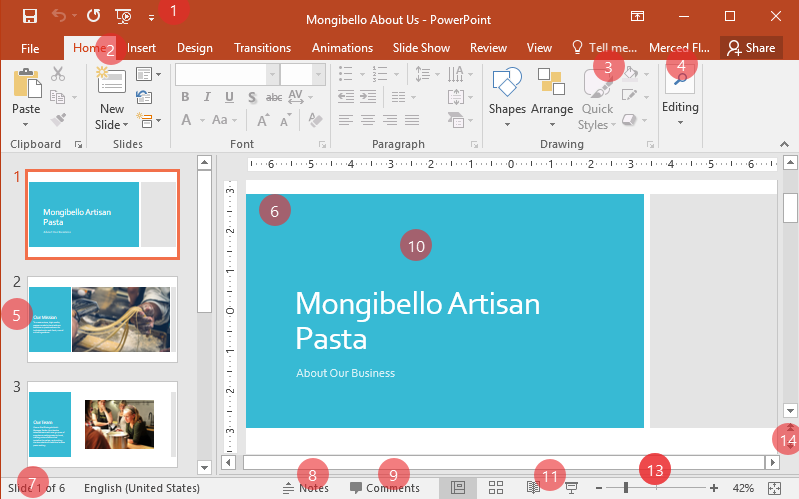Getting to know PowerPoint
PowerPoint 2016 is similar to PowerPoint 2013 and PowerPoint 2010. If you've previously used these versions, PowerPoint 2016 should feel familiar. But if you are new to PowerPoint or have more experience with older versions, you should first take some time to become familiar with the PowerPoint 2016 interface.
The PowerPoint interface
When you open PowerPoint for the first time, the Start Screen will appear. From here, you'll be able to create a new presentation, choose a template, and access your recently edited presentations. From the Start Screen, locate and select Blank Presentation to access the PowerPoint interface.

Click the buttons in the interactive below to become familiar with the PowerPoint interface.

- Quick Access Toolbar: The Quick Access Toolbar lets you access common commands no matter which tab is selected. You can customize the commands depending on your preference.
- The Ribbon: the Ribbon contains all of the commands you will need to perform common tasks in PowerPoint. It has multiple tabs, each with several groups of commands.
- Tell Me: The Tell me box works like a search bar to help you quickly find tools or commands you want to use.
- Microsoft Account: From here, you can access your Microsoft account information, view your profile, and switch accounts.
- Slide Navigation Pane: The slide navigation pane allows you to view and organize the slides in your presentation.
- Ruler: The Ruler is located at the top and to the left of your current slide. It makes it easy to align text and objects on your slide.
- Slide Number Indicator: Here, you can quickly see the total number of slides in your presentation, as well as which slide you are viewing.
- Notes: Click Notes to add notes to your current slide. Often called speaker notes, they can help you deliver or prepare for your presentation.
- Comments: Reviewers can leave comments on any slide. Click Comments to view comments for the current slide.
- Slide Pane: Here, you can view and edit the selected slide.
- Zoom Control: Click and drag the slider to use the zoom control. The number to the right of the slider reflects the zoom percentage.
- .
- Zoom Control: Click and drag the slider to use the zoom control. The number to the right of the slider reflects the zoom percentage.
The Ribbon and Quick Access Toolbar are where you will find the commands to perform common tasks in PowerPoint. Backstage view gives you various options for saving, opening a file, printing, and sharing your document..

